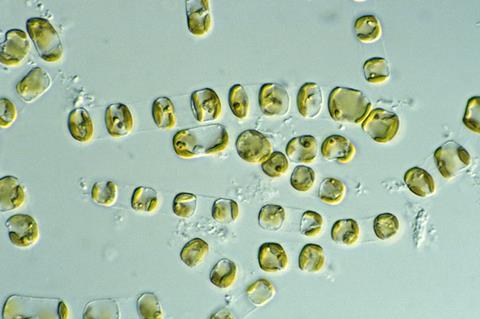Spring weather brings welcome conditions for flowers and plant life to bloom across the land. The right mixture of temperature, moisture, and light helps keep the green world vibrant.

Underwater plant life generally responds to similar environmental encouragements, but a curious discovery in Lake Erie circa 2012 led microbiologists to study an unseasonal display of winter abundance. Blooms of diatoms—microscopic, photosynthetic algae—were alive and well beneath (and within) the lake’s ice cover.
“Some of the main winter-spring diatom bloom formers, like Aulacoseira islandica, have a symbiotic relationship with heterotrophic bacteria capable of forming tiny ice crystals, which over time causes the diatom filaments to become buoyant—just as ice cubes float in your favorite beverage,” said Brittany Zepernick, a post-doctoral researcher and SEC Emerging Scholar in UT’s Department of Microbiology.
Diatom ice cubes
These ‘diatom ice cubes’ float to the Lake Erie ice cover and embed within it, putting them in position to absorb the light needed to perform photosynthesis throughout the winter months. It was good news for diatoms, which are a vital component of the cumulative ecosystem in lakes and oceans across the globe.
This curious adaptation is threatened, though, as warming global temperatures have led to widespread ice decline across the Great Lakes, leaving Lake Erie in a nearly ice-free state in several recent winters and leaving diatoms stuck in murky, light-deprived waters. In these new ’climatically uncharted waters’, the adaptations that benefitted these winter diatoms for so long suddenly ceased to serve them.
Zepernick and colleagues turned to the shores of Lake Erie to investigate the evolving situation. With the help of the US and Canadian Coast Guard, they sampled the ice-covered (in 2019) and ice-free (in 2020) winter waters of Lake Erie to learn how diatoms were responding to changing environmental conditions. They recently published their work in the ISME Journal—Multidisciplinary Journal of Microbial Ecology.
Dominant genera
Two main diatom genera dominate the winter blooms: Aulacoseira islandica and Stephanodiscus spp.
“The abundance of Stephanodiscus spp. was approximately 70 per cent lower in the ice-free water column of 2020 compared to the ice-covered water column of 2019,” said Zepernick. “Likewise, the abundance of Aulacoseira islandica was around 50 per cent lower in the ice-free water column compared to the ice-covered water column.”
With ice cover across the Great Lakes at record lows—from around 80 per cent covered in ice in 2018 and 2019 to just 8 per cent covered in 2023—researchers expect this trend will continue in future winters.
The next step is studying how this impacts Lake Erie, which joins the other Laurentian Great Lakes of the US and Canada to cumulatively contain approximately 20 per cent of the globe’s fresh water.
Critical importance
“Despite the critical importance of this system, we didn’t know diatom blooms even formed in the winter-spring months until around 2012,” said Zepernick. “Many researchers have referred to the winter water column as a ‘New Frontier’ or a ‘black box.’ What we do know is that diatoms are critically important to regional lake ecosystems and global climate.”
Diatoms make up an estimated 20 per cent of global carbon sequestration and oxygen production, play an enhanced role in global biogeochemical cycles, and represent a critical component of the aquatic ecosystem in freshwater systems.
“Hence, the large-scale changes already underway to the winter-spring diatom communities in Lake Erie and other lakes across the globe will result in large-scale biological and biogeochemical change,” said Zepernick.
Potential to adapt
The light at the end of the icy tunnel could rely on the diatoms’ potential to adapt. Zepernick’s recent work indicates they could possibly form clusters with adhesive proteins called fasciclins to “raft” to the surface of the muddy waters via “underwater waves” produced by wind, convection, and underwater currents.
Another adaptation Zepernick hinted at was that diatoms could increase their use of proton-pumping rhodopins (PPRs)—light harvesting, retinal-containing proteins that could serve as an alternative to classical photosynthesis. She is currently attempting to isolate freshwater diatoms from Lake Erie samples that possess PPRs to create a model freshwater diatom-PPR system for further study. Her findings could offer clues to the diatoms’ next move in a rapidly changing climate.
“PPRs are a hot topic within marine literature, yet we know very little about how these mechanisms apply to freshwater systems and taxa,” she said. “I am interested in elucidating the benefits PPRs may confer to both freshwater and marine diatoms across a variety of emerging—and future—climatic stressors.”







No comments yet